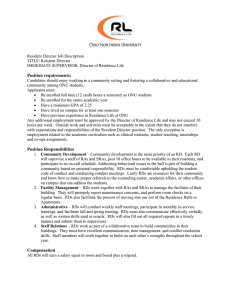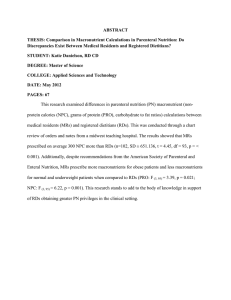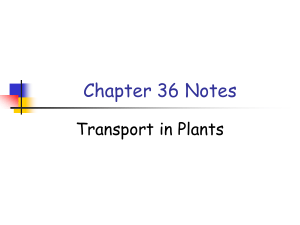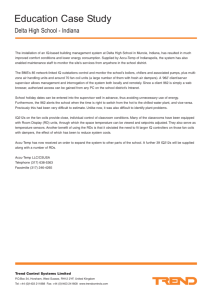Resin duct size and density as ecophysiological traits in fire... of Pseudotsuga menziesii and Larix occidentalis
advertisement
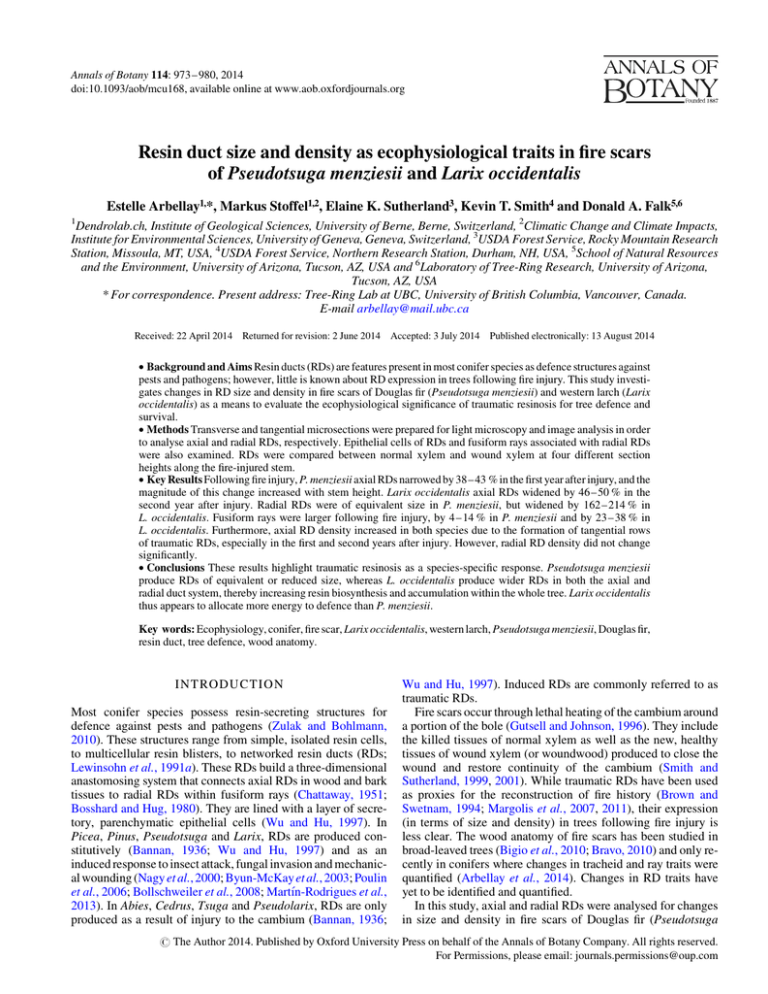
Annals of Botany 114: 973– 980, 2014 doi:10.1093/aob/mcu168, available online at www.aob.oxfordjournals.org Resin duct size and density as ecophysiological traits in fire scars of Pseudotsuga menziesii and Larix occidentalis Estelle Arbellay1,*, Markus Stoffel1,2, Elaine K. Sutherland3, Kevin T. Smith4 and Donald A. Falk5,6 1 Dendrolab.ch, Institute of Geological Sciences, University of Berne, Berne, Switzerland, 2Climatic Change and Climate Impacts, Institute for Environmental Sciences, University of Geneva, Geneva, Switzerland, 3USDA Forest Service, Rocky Mountain Research Station, Missoula, MT, USA, 4USDA Forest Service, Northern Research Station, Durham, NH, USA, 5School of Natural Resources and the Environment, University of Arizona, Tucson, AZ, USA and 6Laboratory of Tree-Ring Research, University of Arizona, Tucson, AZ, USA * For correspondence. Present address: Tree-Ring Lab at UBC, University of British Columbia, Vancouver, Canada. E-mail arbellay@mail.ubc.ca Received: 22 April 2014 Returned for revision: 2 June 2014 Accepted: 3 July 2014 Published electronically: 13 August 2014 † Background and Aims Resin ducts (RDs) are features present in most conifer species as defence structures against pests and pathogens; however, little is known about RD expression in trees following fire injury. This study investigates changes in RD size and density in fire scars of Douglas fir (Pseudotsuga menziesii) and western larch (Larix occidentalis) as a means to evaluate the ecophysiological significance of traumatic resinosis for tree defence and survival. † Methods Transverse and tangential microsections were prepared for light microscopy and image analysis in order to analyse axial and radial RDs, respectively. Epithelial cells of RDs and fusiform rays associated with radial RDs were also examined. RDs were compared between normal xylem and wound xylem at four different section heights along the fire-injured stem. † Key Results Following fire injury, P. menziesii axial RDs narrowed by 38 –43 % in the first year after injury, and the magnitude of this change increased with stem height. Larix occidentalis axial RDs widened by 46 –50 % in the second year after injury. Radial RDs were of equivalent size in P. menziesii, but widened by 162–214 % in L. occidentalis. Fusiform rays were larger following fire injury, by 4–14 % in P. menziesii and by 23 –38 % in L. occidentalis. Furthermore, axial RD density increased in both species due to the formation of tangential rows of traumatic RDs, especially in the first and second years after injury. However, radial RD density did not change significantly. † Conclusions These results highlight traumatic resinosis as a species-specific response. Pseudotsuga menziesii produce RDs of equivalent or reduced size, whereas L. occidentalis produce wider RDs in both the axial and radial duct system, thereby increasing resin biosynthesis and accumulation within the whole tree. Larix occidentalis thus appears to allocate more energy to defence than P. menziesii. Key words: Ecophysiology, conifer, fire scar, Larix occidentalis, western larch, Pseudotsuga menziesii, Douglas fir, resin duct, tree defence, wood anatomy. IN T RO DU C T IO N Most conifer species possess resin-secreting structures for defence against pests and pathogens (Zulak and Bohlmann, 2010). These structures range from simple, isolated resin cells, to multicellular resin blisters, to networked resin ducts (RDs; Lewinsohn et al., 1991a). These RDs build a three-dimensional anastomosing system that connects axial RDs in wood and bark tissues to radial RDs within fusiform rays (Chattaway, 1951; Bosshard and Hug, 1980). They are lined with a layer of secretory, parenchymatic epithelial cells (Wu and Hu, 1997). In Picea, Pinus, Pseudotsuga and Larix, RDs are produced constitutively (Bannan, 1936; Wu and Hu, 1997) and as an induced response to insect attack, fungal invasion and mechanical wounding (Nagy et al., 2000; Byun-McKay et al., 2003; Poulin et al., 2006; Bollschweiler et al., 2008; Martı́n-Rodrigues et al., 2013). In Abies, Cedrus, Tsuga and Pseudolarix, RDs are only produced as a result of injury to the cambium (Bannan, 1936; Wu and Hu, 1997). Induced RDs are commonly referred to as traumatic RDs. Fire scars occur through lethal heating of the cambium around a portion of the bole (Gutsell and Johnson, 1996). They include the killed tissues of normal xylem as well as the new, healthy tissues of wound xylem (or woundwood) produced to close the wound and restore continuity of the cambium (Smith and Sutherland, 1999, 2001). While traumatic RDs have been used as proxies for the reconstruction of fire history (Brown and Swetnam, 1994; Margolis et al., 2007, 2011), their expression (in terms of size and density) in trees following fire injury is less clear. The wood anatomy of fire scars has been studied in broad-leaved trees (Bigio et al., 2010; Bravo, 2010) and only recently in conifers where changes in tracheid and ray traits were quantified (Arbellay et al., 2014). Changes in RD traits have yet to be identified and quantified. In this study, axial and radial RDs were analysed for changes in size and density in fire scars of Douglas fir (Pseudotsuga # The Author 2014. Published by Oxford University Press on behalf of the Annals of Botany Company. All rights reserved. For Permissions, please email: journals.permissions@oup.com 974 Arbellay et al. — Ecophysiology of resin ducts in fire scars of conifers menziesii) and western larch (Larix occidentalis). Epithelial cells of RDs and fusiform rays associated with radial RDs were also examined. Resin ducts were compared between normal xylem and wound xylem at four different section heights along the fire-injured stem. The extension of traumatic RDs has been shown to be quite significant in the upward direction (Lev-Yadun, 2002; Bollschweiler et al., 2008; Schneuwly et al., 2009b). The ecophysiological significance of traumatic resinosis for tree defence and survival is addressed. MAT ERI ALS A ND METH O DS Field campaign and sample preparation In mid-August 2003, the lightning-ignited Black Mountain fire burned 2800 ha of the Lolo National Forest near Missoula, west central Montana, USA. In late August through September 2011, 32 Pseudotsuga menziesii (Mirb.) Franco, 11 Larix occidentalis Nutt. and 18 Pinus ponderosa P.Lawson & C.Lawson trees with charred bark were sampled in the Dry Gulch area (46852′ N/114812′ W, 1787 m a.s.l.; E. K. Sutherland, USDA Forest Service, Missoula, USA, pers. comm.). Cross-sections were taken at 25 cm intervals up to the complete height of the bark char. For this study, two scarred trees each of P. menziesii and L. occidentalis were chosen for wood anatomical analysis (Table 1), which was performed on cross-sections taken at four different section heights (25, 50, 75 and 100 cm above the ground surface) along the fire-injured stem (Fig. 1A). In total, 16 cross-sections were sectioned with a chisel to obtain a wood block where RDs could be compared between normal xylem and wound xylem within 4 cm from the wound margin (Fig. 1B). Each wood block was further split into two 2 cm wide pieces for preparation of 15 mm thick microsections with a sliding microtome. In a first step, transverse microsections (Fig. 1C) were prepared to analyse axial RDs and their epithelial cells in several rings formed pre-fire and in the first and second rings formed post-fire (rings 1 and 2). Several rings were investigated in normal xylem in order to constitute an adequate population of control RDs for comparison between normal xylem and wound xylem. Only the first and second rings formed post-fire TA B L E 1. Characteristics of the four trees analysed SH ¼ 25 cm SH ¼ 50 cm SH ¼ 75 cm SH ¼ 100 cm Age (years) P. menziesii PSM1 PSM2 LAO1 LAO2 L. occidentalis 97 47 108 124 TC (cm) WS (%) TC (cm) WS (%) TC (cm) WS (%) TC (cm) WS (%) 71 61 49 71 58 54 53 46 68 57 44 68 53 47 64 50 64 52 39 64 53 27 62 53 60 51 42 62 52 20 52 16 SH, section height above the ground surface; TC, tree circumference at section height; WS, wound size at section height, i.e. percentage of cambium killed. C B NX A D 1 2 WX 100 75 Bark 50 25 4 cm 0 cm F I G . 1. Study design for wood anatomical analysis. (A) Resin ducts (RDs) were analysed in cross-sections taken at four different section heights (25, 50, 75 and 100 cm above the ground surface) along the fire-injured stem. (B) Cross-sections were sectioned with a chisel to obtain a wood block where RDs could be compared between normal xylem (NX) and wound xylem (WX) within 4 cm from the wound margin, indicated by a star. The dashed line shows the position of the cambium at the time of fire injury. (C) Transverse microsections were prepared to analyse axial RDs and their epithelial cells in several rings formed pre-fire and in the first and second rings formed post-fire (rings 1 and 2). (D) Tangential microsections were prepared to analyse radial RDs, their epithelial cells and their associated fusiform rays, requiring one cut through normal xylem and one cut through wound xylem. Arbellay et al. — Ecophysiology of resin ducts in fire scars of conifers 975 TA B L E 2. Changes in the size of axial resin ducts (ADLAa) between normal xylem (NX) and wound xylem (WX, rings 1 and 2) for the four trees analysed SH ¼ 25 cm PSM1 NX – WX ring 1 NX – WX ring 2 PSM2 NX – WX ring 1 NX – WX ring 2 LAO1 NX – WX ring 1 NX – WX ring 2 LAO2 NX – WX ring 1 NX – WX ring 2 SH ¼ 50 cm SH ¼ 75 cm SH ¼ 100 cm All SH P-value D (%) P-value D (%) P-value D (%) P-value D (%) P-value D (%) <0.001 <0.001 –19 130 <0.001 0.412 – 26 –5 <0.001 0.135 – 43 +8 <0.001 <0.001 – 67 – 61 <0.001 0.398 –38 –4 <0.001 <0.001 –21 –36 <0.001 <0.001 – 25 – 40 <0.001 <0.001 – 43 – 61 <0.001 <0.001 – 43 – 67 <0.001 <0.001 –43 –46 0.243 <0.001 +6 150 <0.001 <0.001 – 49 150 0.007 <0.001 – 17 178 0.002 0.986 – 21 –1 <0.001 <0.001 –20 150 0.327 <0.001 +5 129 0.010 <0.001 120 162 0.012 <0.001 – 16 155 0.001 <0.001 – 22 124 0.468 <0.001 –3 146 ADLAa, average duct lumen area of axial resin ducts; SH, section height above the ground surface. One-way ANOVA. Significant results appear in bold. were examined, as traumatic RDs were mostly produced in those rings. In a second step, tangential microsections (Fig. 1D) were prepared to analyse radial RDs, their epithelial cells and their associated fusiform rays, requiring two radial cuts (one through normal xylem and one through wound xylem). The latter cut was performed about 2 mm inside wound xylem, i.e. within ring 1 or 2. All microsections (96 in total) were stained with a 1 % safranin and astrablue solution, rinsed with water, alcohols and xylol, and mounted permanently on microscope slides using Canada balsam. of wound xylem. ADLAa decreased significantly in ring 1, by 38 % in PSM1 and by 43 % in PSM2 (Table 2). ADLAa also decreased significantly in ring 2, by 46 % in PSM2 (PSM1 only showed that reaction at 100 cm above the ground surface). This narrowing of RDs increased with stem height (Fig. 2A, B). For example, in ring 1 of PSM1, the decrease ranged from 19 % at 25 cm to 67 % at 100 cm (Table 2). The ANEC decreased from ten to six cells in both rings. Moreover, the number of RDs increased in wound xylem compared with normal xylem (Fig. 2A, B). The density of RDs decreased by 44 % from ring 1 to ring 2. Wood anatomical analysis Images of the transverse and tangential microsections were captured at ×25 and ×100 magnification, respectively, with a digital camera mounted on a light microscope. The number and density of RDs as well as their average number of epithelial cells (ANEC) were obtained from direct observation of the captured images. WinCELL software (Régent Instruments Inc., 2004) was used to measure average duct lumen area (ADLA), average ray height (ARH) and average ray width (ARW); ADLAa and ADLAr designate the lumen size of axial and radial RDs, respectively. Measurements were made at the four section heights and in the rings mentioned previously. Within the 4 cm wide tangential window, all axial RDs were recorded, whereas radial RDs and fusiform rays were measured at 0.5 cm intervals along that window, within about 1 mm2 at each location. One-way analysis of variance (ANOVA) was used to determine whether there were significant (P , 0.05) changes in RD traits between normal xylem and wound xylem. For ease of comparison, results refer to data from the four section heights unless otherwise specified. R E S U LTS Axial RDs in P. menziesii The ADLAa values pre-fire were 1696 and 2112 mm2 in PSM1 and PSM2, respectively. Results were similar in the two rings Axial RDs in L. occidentalis The ADLAa values pre-fire were 3062 and 3388 mm2 in LAO1 and LAO2, respectively. Results differ between the two rings of wound xylem. ADLAa decreased significantly in ring 1, by 20 % in LAO1 (LAO2 only showed that reaction at 75 and 100 cm above the ground surface). In contrast, ADLAa increased significantly in ring 2, by 50 % in LAO1 and by 46 % in LAO2 (Table 2). These responses did not increase with stem height (Fig. 2C, D). The ANEC decreased from 11 to nine cells in ring 1 and increased from 11 to 17 cells in ring 2. As in P. menziesii, the number of RDs increased in wound xylem compared with normal xylem (Fig. 2C, D). The density of RDs decreased by 53 % from ring 1 to ring 2. Radial RDs and fusiform rays in P. menziesii The ADLAr values pre-fire were 360 and 315 mm2 in PSM1 and PSM2, respectively. The ARH and ARW values pre-fire were respectively 264 and 274 mm in PSM1 and PSM2, and 44 and 43 mm in PSM1 and PSM2. The size and density of RDs did not change significantly in wound xylem compared with normal xylem (Fig. 3A; Table 3). The ANEC mostly remained constant with six cells. However, fusiform rays were larger in wound xylem, by 9–14 % for ARH and by 4–13 % for ARW (Table 3). 976 Arbellay et al. — Ecophysiology of resin ducts in fire scars of conifers P. menziesii 6 A B Discriminant scores from function 1 NX – WX ring 1 NX – WX ring 2 3 0 PSM2 –3 NX WX WX r = 0·767 0 1000 All SH SH = 25 and 50 cm SH = 75 and 100 cm 2000 ADLAa 3000 4000 PSM2 NX WX WX r = 0·826 0 1000 All SH SH = 25 and 50 cm SH = 75 and 100 cm 2000 (µm2) ADLAa 3000 4000 (µm2) L. occidentalis 4 C D Discriminant scores from function 1 NX – WX ring 1 NX – WX ring 2 2 0 –2 –4 LAO2 NX WX WX r = –0·055 0 2000 4000 All SH SH = 25 and 50 cm SH = 75 and 100 cm 6000 8000 10 000 LAO2 NX WX WX r = 0·502 0 2000 ADLAa (µm2) 4000 All SH SH = 25 and 50 cm SH = 75 and 100 cm 6000 8000 10 000 ADLAa (µm2) F I G . 2. Changes in average duct lumen area of axial resin ducts (ADLAa), presented for (A, B) one tree of P. menziesii and (C, D) one tree of L. occidentalis. Discriminant analysis plots allow comparison between normal xylem (NX) and wound xylem (WX, rings 1 and 2). Section heights (SH) were paired in WX and considered all together in NX. Radial RDs and fusiform rays in L. occidentalis 2 The ADLAr values pre-fire were 583 and 705 mm in LAO1 and LAO2, respectively. The ARH and ARW values pre-fire were respectively 373 and 403 mm in LAO1 and LAO2, and 46 and 49 mm in LAO1 and LAO2. In contrast to P. menziesii, ADLAr increased significantly in wound xylem, by 162 % in LAO1 and by 214 % in LAO2 (Table 3). This widening of RDs did not increase with stem height (Fig. 3B). The ANEC increased from nine to 11 cells. As in P. menziesii, the density of RDs did not change significantly in wound xylem compared with normal xylem (Fig. 3B), and fusiform rays were larger in wound xylem, by 23 % for ARH and by 26–38 % for ARW (Table 3). D IS C US S IO N Changes in RD size Following fire injury, P. menziesii and L. occidentalis showed some changes in the lumen size of axial and radial RDs. The number of epithelial cells adjusted to the new RD size, which Arbellay et al. — Ecophysiology of resin ducts in fire scars of conifers P. menziesii 60 A NX – WX ARW (µm) 50 40 30 20 PSM2 NX WX WX r = 0·395 0 200 All SH SH = 25 and 50 cm SH = 75 and 100 cm 400 600 800 ADLAr (µm2) L. occidentalis 90 B NX – WX 80 ARW (µm) 70 60 50 LAO2 40 30 NX WX WX r = 0·855 0 1000 All SH SH = 25 and 50 cm SH = 75 and 100 cm 2000 3000 4000 ADLAr (µm2) F I G . 3. Changes in average duct lumen area of radial resin ducts (ADLAr) and in average ray width (ARW) of their associated fusiform rays, presented for (A) one tree of P. menziesii and (B) one tree of L. occidentalis. Discriminant analysis plots allow comparison between normal xylem (NX) and wound xylem (WX). Section heights (SH) were paired in WX and considered all together in NX. is consistent with the theoretical description of RD formation from epithelial cells (Kuroda, 1986). In more detail, P. menziesii axial RDs were narrower in the first year after injury (Fig. 4A), and the magnitude of this change increased with stem height. In contrast, L. occidentalis axial RDs were wider in the second year after injury (Fig. 4B). Radial RDs were of equivalent size in P. menziesii, but were wider in L. occidentalis (Fig. 4C). Similarly, injury inflicted on trees with an increment borer decreased axial RD size in P. menziesii and increased it in L. occidentalis (Hudgins et al., 2003a). It is likely that mechanical wounding of either origin 977 raised auxin and ethylene concentrations in the injured area (Aloni and Zimmermann, 1984; Imaseki, 1985). These phytohormones are believed to have caused the differentiation of narrower tracheids and larger rays in fire-scarred P. menziesii and L. occidentalis (Arbellay et al., 2014). We suggest that the narrower axial RDs in wound xylem of P. menziesii are the result of rapid conduit differentiation due to high auxin concentration, as is theorized in the case of reduced size tracheids and vessels (Aloni and Zimmermann, 1983, 1984; Lovisolo et al., 2002; Anfodillo et al., 2012). This decrease in RD size was most obvious in the first year after injury, presumably because the level of auxin was higher. The magnitude of this change increased with stem height, as the fire scar locally obstructed the basipetal flow of auxin and raised the auxin concentration, with decreasing importance from the top to the bottom of the scar (Aloni and Zimmermann, 1983, 1984). Moreover, cambial reactivation in Pseudotsuga occurs on the xylem side first, as opposed to on the phloem side in Larix (Larson, 1994). The prompt start of xylogenesis in Pseudotsuga ensures that traumatic resinosis in P. menziesii occurred at a high auxin level. Vice versa, the wider axial RDs in wound xylem of L. occidentalis might reflect slower conduit differentiation due to lower auxin concentration, as the start of xylogenesis is delayed in Larix compared with Pseudotsuga. This increase in RD size was most obvious in the second year after injury, presumably because the level of auxin was even lower. Furthermore, these contrasting results between P. menziesii and L. occidentalis might also stem from species-specific sensitivity to wound-induced ethylene, as suggested by Arbellay et al. (2014) to explain the different amount of ray tissue among Pinaceae following fire injury. Ethylene promotes RD formation as well as ray enlargement (Barker, 1979; Yamamoto and Kozlowski, 1987; Yamamoto et al., 1987; Fahn, 1988; Lev-Yadun and Aloni, 1992). Fusiform rays associated with radial RDs were indeed larger in wound xylem of both species whether they accommodated RDs of equivalent or enlarged size as in P. menziesii and L. occidentalis, respectively. Several studies have contributed to establishing methyl jasmonate as the signalling agent responsible for ethylene biosynthesis and the induction of defence responses in conifers (Franceschi et al., 2002; Martin et al., 2002; Hudgins et al., 2003a, 2004; Hudgins and Franceschi, 2004). Changes in RD density Axial RDs are usually less numerous than radial RDs in Pseudostuga and Larix (Larson, 1994), which was no longer verified in P. menziesii and L. occidentalis following fire injury. While radial RD density did not change significantly, axial RD density increased in wound xylem of both species due to the formation of tangential rows of traumatic RDs (Fig. 4A). The production of numerous traumatic RDs in wood and bark tissues along with the activation of polyphenolic parenchyma cells in the bark are characteristic induced defence responses of P. menziesii and L. occidentalis (Hudgins et al., 2003a, 2004; Hudgins and Franceschi, 2004). Moreover, the trees of this study were injured by fire after cessation of cambial growth. Traumatic resinosis was initiated in the following growing season and was most manifest in the first and second years after injury, concurring with observations in Larix decidua, 978 Arbellay et al. — Ecophysiology of resin ducts in fire scars of conifers TA B L E 3. Changes in the size of radial resin ducts (ADLAr) and fusiform rays (ARH, ARW) between normal xylem (NX) and wound xylem (WX) for the four trees analysed SH ¼ 25 cm PSM1 NX – WX PSM2 NX – WX LAO1 NX – WX LAO2 NX – WX SH ¼ 50 cm SH ¼ 75 cm SH ¼ 100 cm All SH P-value D (%) P-value D (%) P-value D (%) P-value D (%) P-value D (%) ADLAr ARH ARW 0.826 0.653 <0.001 +3 +3 114 0.393 0.906 0.326 – 10 –1 +3 0.671 <0.001 <0.001 –4 125 117 0.034 0.417 0.009 – 27 +5 110 0.058 0.002 <0.001 –11 19 113 ADLAr ARH ARW 0.969 0.036 0.177 +1 120 –6 0.010 0.007 0.112 143 117 +5 0.015 <0.001 0.868 –22 131 –1 0.744 0.198 <0.001 +3 –8 119 0.329 <0.001 0.034 +7 114 14 ADLAr ARH ARW <0.001 0.002 <0.001 1192 128 126 <0.001 0.003 <0.001 1104 134 125 <0.001 0.037 <0.001 1186 117 136 <0.001 0.040 0.001 1109 115 118 <0.001 <0.001 <0.001 1162 123 126 ADLAr ARH ARW <0.001 0.133 <0.001 1124 +15 125 <0.001 0.786 <0.001 1177 +3 156 <0.001 0.179 <0.001 1157 +8 140 <0.001 0.272 <0.001 1171 +10 128 <0.001 0.080 <0.001 1214 +8 138 ADLAr, average duct lumen area of radial resin ducts; ARH, average ray height; ARW, average ray width; SH, section height above the ground surface. One-way ANOVA. Significant results appear in bold. A B C WX NX 180 µm 150 µm 50 µm F I G . 4. Resin ducts (RDs) in fire-scarred P. menziesii and L. occidentalis. (A) Following fire injury, axial RDs in wound xylem of both species were aligned in one or more tangential rows of traumatic RDs, as in P. menziesii where traumatic RDs were narrower than normal RDs in the first post-fire ring. (B) In L. occidentalis, traumatic RDs were sometimes locally absent in the first post-fire ring, designated by black arrows, and were wider than normal RDs in the second post-fire ring. (C) Fusiform rays were larger in wound xylem of both species, but only in L. occidentalis did radial RDs increase in size between normal xylem (NX) and wound xylem (WX). Picea abies and Abies alba trees injured by mass-movement processes during dormancy (Bollschweiler et al., 2008; Stoffel and Hitz, 2008; Schneuwly et al., 2009a, b). The reaction faded over time, with the density of RDs already reduced by about 50 % in the second year after injury in both species, and often disappeared completely as early as in the fourth year after injury. Ecophysiological significance of traumatic resinosis Pseudotsuga and Larix synthesize relatively little resin constitutively compared with Pinus (Lewinsohn et al., 1991b). They must rely on further constitutive defences against pests and pathogens, such as lignified cells (Wainhouse et al., 1997) and calcium oxalate crystals (Hudgins et al., 2003b). More importantly, they deploy a highly inducible defence strategy in which the formation of traumatic RDs is crucial (Hudgins et al., 2003a, 2004; Hudgins and Franceschi, 2004). Both species produced numerous traumatic RDs in the axial duct system in an attempt to compartmentalize decay after wounding (Tippett and Shigo, 1981; Oven and Torelli, 1999). Resin can act as a mechanical barrier when its volatile terpenes evaporate and leave a hardened plug in the ducts that prevents the entry of water and invaders (Hillis, 1987; Pearce, 1996). Traumatic resin, in particular, might act as a chemical barrier, as it appears to be more toxic or fungistatic than constitutive resin (Solheim, 1991; Nagy et al., 2000). Interestingly, L. occidentalis produced wider RDs in both the axial and radial duct system, thereby increasing resin biosynthesis and accumulation within the whole tree. It Arbellay et al. — Ecophysiology of resin ducts in fire scars of conifers could be argued that L. occidentalis allocates more energy to defence than P. menziesii, which only produced RDs of equivalent or reduced size. This study demonstrates that fire injury altered RD expression in P. menziesii and L. occidentalis and, more importantly, highlights traumatic resinosis as a species-specific response. ACK N OW L E DG E M E N T S We thank the Lolo National Forest, Missoula Ranger District for their co-operation during the planning and sampling phase of this study. This work was supported in part by US Forest Service Research and Development and National Fire Plan Research funds. We are grateful for the assistance of Josh Farella, David K. Wright and especially Ian R. Hyp (all US Forest Service Rocky Mountain Research Station) for sampling and preparing the cross-sections. LIT ERAT URE CITED Aloni R, Zimmermann MH. 1983. The control of vessel size and density along the plant axis: a new hypothesis. Differentiation 24: 203– 208. Aloni R, Zimmermann MH. 1984. Length, width and pattern of regenerative vessels along strips of vascular tissue. Botanical Gazette 145: 50–54. Anfodillo T, Deslauriers A, Menardi R, Tedoldi L, Petit G, Rossi S. 2012. Widening of xylem conduits in a conifer tree depends on the longer time of cell expansion downwards along the stem. Journal of Experimental Botany 63: 837– 845. Arbellay E, Stoffel M, Sutherland EK, Smith KT, Falk DA. 2014. Changes in tracheid and ray traits in fire scars of North American conifers and their ecophysiological implications. Annals of Botany 114: 223– 232. Bannan MW. 1936. Vertical resin ducts in the secondary wood of the Abietineae. New Phytologist 35: 11–46. Barker JE. 1979. Growth and wood properties of Pinus radiata in relation to applied ethylene. New Zealand Journal of Forest Science 9: 15–19. Bigio E, Gärtner H, Conedera M. 2010. Fire-related features of wood anatomy in a sweet chestnut (Castanea sativa) coppice in southern Switzerland. Trees 24: 643–655. Bollschweiler M, Stoffel M, Schneuwly DM, Bourqui K. 2008. Traumatic resin ducts in Larix decidua stems impacted by debris flows. Tree Physiology 28: 255–263. Bosshard HH, Hug UE. 1980. The anastomoses of the resin canal system in Picea abies (L.) Karst., Larix decidua Mill. and Pinus sylvestris L. Holz als Roh- und Werkstoff 38: 325–328. Bravo S. 2010. Anatomical changes induced by fire-damaged cambium in two native tree species of the Chaco region, Argentina. IAWA Journal 31: 283–292. Brown PM, Swetnam TW. 1994. A cross-dated fire history from coast redwood near Redwood National Park, California. Canadian Journal of Forest Research 24: 21–31. Byun-McKay SA, Hunter WL, Godard K-A, et al. 2003. Insect attack and wounding induce traumatic resin duct development and gene expression of (–)-pinene synthase in Sitka spruce. Plant Physiology 133: 368 –378. Chattaway MM. 1951. The development of horizontal canals in rays. Australian Journal of Scientific Research 4: 1– 11. Fahn A. 1988. Secretory tissues and factors influencing their development. Phyton 28: 13– 26. Franceschi VR, Krekling T, Christiansen E. 2002. Application of methyl jasmonate on Picea abies (Pinaceae) stems induces defense-related responses in phloem and xylem. American Journal of Botany 89: 578–586. Gutsell SL, Johnson EA. 1996. How fire scars are formed: coupling a disturbance process to its ecological effect. Canadian Journal of Forest Research 26: 166–174. Hillis WE. 1987. Heartwood and tree exudates. Berlin: Springer. Hudgins JW, Franceschi VR. 2004. Methyl jasmonate-induced ethylene production is responsible for conifer phloem defense responses and reprogramming of stem cambial zone for traumatic resin duct formation. Plant Physiology 135: 2134– 2149. 979 Hudgins JW, Christiansen E, Franceschi VR. 2003a. Methyl jasmonate induces changes mimicking anatomical defenses in diverse members of the Pinaceae. Tree Physiology 23: 361– 371. Hudgins JW, Krekling T, Franceschi VR. 2003b. Distribution of calcium oxalate crystals in the secondary phloem of conifers: a constitutive defense mechanism? New Phytologist 159: 677–690. Hudgins JW, Christiansen E, Franceschi VR. 2004. Induction of anatomically based defense responses in stems of diverse conifers by methyl jasmonate: a phylogenetic perspective. Tree Physiology 24: 251– 264. Imaseki H. 1985. Hormonal control of wound-induced responses. In: Pharis RP, Reid DM, eds. Encyclopedia of plant physiology. New Series, Volume 11, Part 3. Berlin: Springer, 485– 512. Kuroda K. 1986. Wound effects on cytodifferentiation in the secondary xylem of woody plants. Wood Research 72: 67–118. Larson PR. 1994. The vascular cambium. Development and structure. Berlin: Springer. Lev-Yadun S. 2002. The distance to which wound effects influence the structure of secondary xylem of decapitated Pinus pinea. Journal of Plant Growth Regulation 21: 191– 196. Lev-Yadun S, Aloni R. 1992. The role of wounding and partial girdling in differentiation of vascular rays. International Journal of Plant Sciences 153: 348–357. Lewinsohn E, Gijzen M, Savage TJ, Croteau R. 1991a. Defense mechanisms of conifers: relationship of monoterpene cyclase activity to anatomical specialization and oleoresin monoterpene content. Plant Physiology 96: 38–43. Lewinsohn E, Gijzen M, Croteau R. 1991b. Defense mechanisms of conifers: differences in constitutive and wound-induced monoterpene biosynthesis among species. Plant Physiology 96: 44–49. Lovisolo C, Schubert A, Sorce C. 2002. Are xylem radial development and hydraulic conductivity in downwardly-growing grapevine shoots influenced by perturbed auxin metabolism? New Phytologist 156: 65–74. Margolis EQ, Swetnam TW, Allen CD. 2007. A stand-replacing fire history in upper montane forests of the southern Rocky Mountains. Canadian Journal of Forest Research 37: 2227–2241. Margolis EQ, Swetnam TW, Allen CD. 2011. Historical stand-replacing fire in upper montane forests of the Madrean Sky Islands and Mogollon Plateau, southwestern USA. Fire Ecology 7: 88– 107. Martin D, Tholl D, Gershenzon J, Bohlmann J. 2002. Methyl jasmonate induces traumatic resin ducts, terpenoid resin biosynthesis, and terpenoid accumulation in developing xylem of Norway spruce stems. Plant Physiology 129: 1003–1018. Martı́n-Rodrigues N, Espinel S, Sanchez-Zabala J, Ortı́z A, González-Murua C, Duñabeitia MK. 2013. Spatial and temporal dynamics of the colonization of Pinus radiata by Fusarium circinatum, of conidiophora development in the pith and of traumatic resin duct formation. New Phytologist 198: 1215– 1227. Nagy NE, Franceschi VR, Solheim H, Krekling T, Christiansen E. 2000. Wound-induced traumatic resin duct development in stem of Norway spruce (Pinaceae): anatomy and cytochemical traits. American Journal of Botany 87: 302– 313. Oven P, Torelli N. 1999. Response of the cambial zone in conifers to wounding. Phyton 39: 133– 137. Pearce RB. 1996. Antimicrobial defences in the wood of living trees. New Phytologist 132: 203–233. Poulin J, Lavallée R, Mauffette Y, Rioux D. 2006. White pine weevil performances in relation to budburst phenology and traumatic resin duct formation in Norway spruce. Agricultural and Forest Entomology 8: 129– 137. Régent Instruments Inc. 2004. WinCELL Pro V 2004a. www. regentinstruments.com. Schneuwly DM, Stoffel M, Bollschweiler M. 2009a. Formation and spread of callus tissue and tangential rows of resin ducts in Larix decidua and Picea abies following rockfall impacts. Tree Physiology 29: 281–289. Schneuwly DM, Stoffel M, Dorren LKA, Berger F. 2009b. Three-dimensional analysis of the anatomical growth response of European conifers to mechanical disturbance. Tree Physiology 29: 1247–1257. Smith KT, Sutherland EK. 1999. Fire-scar formation and compartmentalization in oak. Canadian Journal of Forest Research 29: 166–171. Smith KT, Sutherland EK. 2001. Terminology and biology of fire scars in selected central hardwoods. Tree-Ring Research 57: 141– 147. Solheim H. 1991. Oxygen deficiency and spruce resin inhibition of growth of fungi associated with Ips typographus. Mycological Research 95: 1387– 1392. 980 Arbellay et al. — Ecophysiology of resin ducts in fire scars of conifers Stoffel M, Hitz OM. 2008. Rockfall and snow avalanche impacts leave different anatomical signatures in tree rings of juvenile Larix decidua. Tree Physiology 28: 1713– 1720. Tippett JT, Shigo AL. 1981. Barriers to decay in conifer roots. European Journal of Forest Pathology 11: 51–59. Wainhouse D, Rose DR, Peace AJ. 1997. The influence of preformed defences on the dynamic wound response in Spruce bark. Functional Ecology 11: 564–572. Wu H, Hu Z-H. 1997. Comparative anatomy of resin ducts of the Pinaceae. Trees 11: 135–143. Yamamoto F, Kozlowski TT. 1987. Effect of ethrel on growth and stem anatomy of Pinus halepensis seedlings. IAWA Bulletin 8: 11– 19. Yamamoto F, Angeles G, Kozlowski TT. 1987. Effect of ethrel on stem anatomy of Ulmus americana seedlings. IAWA Bulletin 8: 3 –10. Zulak KG, Bohlmann J. 2010. Terpenoid biosynthesis and specialized vascular cells of conifer defense. Journal of Integrative Plant Biology 52: 86– 97.
